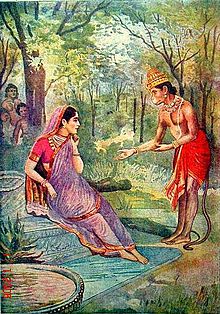Overview
Introduction to Sunderkand
Sunderkand is a significant chapter in the ancient Indian epic, the Ramayana. It is a narrative of the journey of Lord Hanuman to Lanka in search of Sita, the wife of Lord Rama. This chapter explores the multiple languages used in Sunderkand, which adds depth and richness to the story. The characters in Sunderkand come from diverse backgrounds and speak different languages, reflecting the multicultural nature of ancient India. The use of multiple languages in Sunderkand not only showcases the linguistic diversity of the time but also highlights the importance of communication and understanding in the face of adversity. Through the interactions and dialogues of the characters, Sunderkand emphasizes the power of language and its ability to bridge gaps and forge connections.
Importance of Language in Sunderkand
Language plays a crucial role in Sunderkand as it serves as a medium of communication and expression. The importance of language in Sunderkand cannot be overstated, as it allows readers to understand and appreciate the depth and beauty of the text. Through language, the intricate details and profound meanings of the verses are conveyed, enabling readers to connect with the spiritual essence of the epic. Moreover, language also facilitates the preservation and dissemination of Sunderkand, ensuring that future generations can access and study this sacred text. The use of different languages in Sunderkand adds richness and diversity to the narrative, reflecting the cultural and linguistic diversity of the region. Overall, language is a fundamental element in Sunderkand, enhancing its significance and enabling readers to delve into its profound teachings.
Exploring the Multiple Languages of Sunderkand
Sunderkand, a chapter from the Hindu epic Ramayana, holds immense spiritual significance. It depicts the journey of Lord Hanuman to find and deliver a message to Lord Rama‘s wife, Sita, who has been kidnapped by the demon king, Ravana. The story of Sunderkand has been told and retold in multiple languages, showcasing its universal appeal and cultural significance. Exploring the multiple languages in which Sunderkand is available provides a unique perspective on the diversity and richness of Indian literature and spirituality. Each language brings its own nuances and interpretations, adding depth and vibrancy to the narrative. From Sanskrit to Hindi, Gujarati to Bengali, each version of Sunderkand offers a glimpse into the cultural tapestry of India and the devotion of its people. The availability of Sunderkand in multiple languages allows individuals from different regions and linguistic backgrounds to connect with its profound teachings and experience the transformative power of this ancient text.
The Sanskrit Language

History and Significance of Sanskrit
The history and significance of Sanskrit can be traced back to ancient India. Sanskrit is considered to be one of the oldest languages in the world, with a rich literary tradition spanning thousands of years. It is the language of the sacred Hindu scriptures, including the Vedas and the Upanishads. Sanskrit has played a crucial role in the development of various fields of knowledge, such as philosophy, science, mathematics, and linguistics. It is known for its precise grammar and complex structure, making it a highly revered language among scholars and intellectuals. The study of Sanskrit provides insights into the ancient Indian culture, religious practices, and spiritual beliefs. Today, Sanskrit continues to be studied and preserved as a classical language, showcasing the enduring legacy of this ancient language.
Sanskrit Verses in Sunderkand
Sanskrit Verses in Sunderkand
Sunderkand, a chapter from the Indian epic Ramayana, is known for its beautiful Sanskrit verses. These verses, composed by the sage Valmiki, depict the journey of Lord Hanuman to Lanka in search of Sita, the wife of Lord Rama. The Sanskrit verses in Sunderkand not only showcase the literary prowess of Valmiki but also provide insights into the cultural and linguistic heritage of ancient India. The provenance of these verses can be traced back to the Vedic period, making them an important part of India’s rich literary tradition. The verses highlight the profound spiritual and philosophical teachings embedded within the text, making them a valuable source of wisdom for readers. By studying and understanding the Sanskrit verses in Sunderkand, one can gain a deeper appreciation for the ancient language and the timeless wisdom it conveys.
Understanding the Sanskrit Language in Sunderkand
The Sanskrit language plays a significant role in Sunderkand, one of the chapters in the epic Indian scripture, Ramayana. Understanding the Sanskrit language in Sunderkand is crucial for comprehending the depth and beauty of the text. Sanskrit, known as the language of the gods, is considered one of the oldest languages in the world. It has a rich and complex grammar, with a vast vocabulary that allows for precise expression and poetic beauty. In Sunderkand, the Sanskrit verses convey profound spiritual teachings, showcasing the devotion and valor of Lord Hanuman. By delving into the Sanskrit language in Sunderkand, readers can uncover the hidden meanings and symbolism embedded in the text, enhancing their understanding and appreciation of this timeless scripture.
The Hindi Language

Evolution of Hindi
The evolution of Hindi is a fascinating journey that reflects the rich history and cultural diversity of India. Hindi, one of the major languages spoken in India today, has undergone significant changes over the centuries. It has evolved from its early form, known as Old Hindi or Prakrit, to the modern standard Hindi that we use today. The development of Hindi can be traced back to the ancient Indo-Aryan languages and the influence of Sanskrit, which served as the foundation for many Indian languages. Over time, Hindi has absorbed vocabulary and grammatical elements from various regional languages, making it a truly inclusive and dynamic language. Today, Hindi is not only spoken by millions of people in India but also serves as an important lingua franca for communication and cultural exchange. The evolution of Hindi is a testament to the resilience and adaptability of languages, as well as the continuous evolution of Indian society and culture.
Hindi Translations of Sunderkand
Sunderkand is a significant chapter of the Indian epic Ramayana, which narrates the heroic journey of Lord Hanuman. It is a highly revered text in Hinduism and has been translated into multiple languages, including Hindi. The Hindi translations of Sunderkand play a crucial role in making this ancient scripture accessible to a wider audience. These translations not only capture the essence of the original text but also add cultural nuances that resonate with Hindi-speaking readers. Lord Hanuman, the central character of Sunderkand, is depicted in various Hindi translations with reverence and devotion. The translations highlight Lord Hanuman’s unwavering loyalty, his extraordinary powers, and his selfless service to Lord Rama. Through these translations, readers can delve deeper into the divine qualities of Lord Hanuman and gain a deeper understanding of his significance in Hindu mythology.
Interpreting the Hindi Language in Sunderkand
Interpreting the Hindi Language in Sunderkand is crucial for comprehending Sunderkand. Sunderkand, a chapter from the epic Ramayana, is written in Hindi and is rich in symbolism and metaphors. To fully appreciate the depth and meaning of Sunderkand, one must delve into the nuances of the Hindi language. By understanding the language, one can unravel the hidden messages and spiritual teachings embedded in the text. Without a proper understanding of Hindi, the true essence of Sunderkand may be lost. Therefore, it is essential to interpret the Hindi language in Sunderkand to gain a profound understanding of this sacred scripture.
The Tamil Language

Origin and Development of Tamil
The origin and development of Tamil can be traced back to ancient times. Tamil is one of the oldest languages in the world, with a rich literary tradition. It is believed to have evolved from a proto-Dravidian language spoken by the people of the Indus Valley Civilization. Over the centuries, Tamil has undergone various changes and has been influenced by other languages such as Sanskrit and English. Today, Tamil is spoken by millions of people in India, Sri Lanka, and other parts of the world. It has a vibrant literature, including ancient epics like the Sunderkand.
Tamil Translations of Sunderkand
Tamil Translations of Sunderkand
Analyzing the Tamil Language in Sunderkand
The Tamil language plays a significant role in Sunderkand, adding depth and richness to the epic. Analyzing the Tamil language in Sunderkand reveals its unique linguistic features and cultural significance. One of the most important passages in Tamil is the description of Lord Hanuman’s journey to Lanka. This passage showcases the beauty and complexity of the language, with its poetic expressions and vivid imagery. Another notable aspect of the Tamil language in Sunderkand is its influence on the local traditions and customs. The use of Tamil words and phrases in rituals and prayers reflects the deep-rooted connection between the language and the religious practices of the people. Overall, the presence of the Tamil language in Sunderkand highlights the multicultural nature of the epic and emphasizes the importance of linguistic diversity in understanding and appreciating ancient texts.
The Telugu Language

Historical Background of Telugu
The historical background of Telugu is closely intertwined with the epic Ramayan. Telugu, one of the oldest languages in India, has a rich literary tradition that dates back to ancient times. It is believed that the language originated from the script used in the inscriptions found in the caves and temples of Andhra Pradesh. The influence of Ramayan on Telugu literature is evident from the numerous adaptations and retellings of the epic in Telugu. The story of Rama and his adventures in the forest of Sunderkand has been a popular theme in Telugu literature, with many poets and writers exploring different aspects of the epic. The historical background of Telugu is thus deeply rooted in the cultural and literary heritage of India.
Telugu Translations of Sunderkand
Telugu Translations of Sunderkand have played a significant role in making this ancient epic accessible to a wider audience. Sunderkand, a chapter from the Indian epic Ramayana, has been translated into Telugu by several scholars and authors. These translations not only provide a linguistic bridge for Telugu-speaking readers but also offer a deeper understanding of the narrative and its cultural nuances. The Telugu translations of Sunderkand capture the essence of the original text while adding their own unique interpretations. Through these translations, readers can explore the timeless wisdom and moral teachings of Ramayana in their native language.
Decoding the Telugu Language in Sunderkand
Decoding the Telugu Language in Sunderkand is a fascinating journey into the linguistic richness of this ancient text. Telugu, one of the Dravidian languages, is widely spoken in the southern part of India. In Sunderkand, the Telugu language is used to convey profound meanings and emotions. The use of Telugu in Sunderkand showcases the cultural diversity and linguistic versatility of the epic. The passages written in Telugu are significant and provide valuable insights into the narrative. Through the study of Telugu in Sunderkand, scholars and enthusiasts can gain a deeper understanding of the text and appreciate its linguistic nuances.
The Bengali Language

Evolution and Characteristics of Bengali
The evolution and characteristics of Bengali have played a significant role in shaping the cultural identity of the region. Bengali, also known as Bangla, is the official language of Bangladesh and the Indian states of West Bengal, Tripura, and Assam. It belongs to the Indo-Aryan branch of the Indo-European language family and has a rich literary tradition dating back to the 9th century. Bengali literature encompasses a wide range of genres, including poetry, novels, and plays, and has produced renowned authors such as Rabindranath Tagore and Kazi Nazrul Islam. The language has evolved over the centuries, influenced by various factors such as Sanskrit, Persian, and English. Today, Bengali is spoken by millions of people around the world and is an integral part of their cultural and devotional practices.
Bengali Translations of Sunderkand
Bengali translations of Sunderkand provide a unique perspective on this ancient Hindu scripture. These translations allow Bengali-speaking individuals to connect with the essence of Sunderkand in their native language. The Bengali translations not only capture the beauty and depth of the original text but also bring a sense of familiarity and resonance to the readers. Through these translations, readers can delve into the profound teachings and spiritual insights of Sunderkand, enabling them to experience its transformative power in a language they understand and cherish.
Interpreting the Bengali Language in Sunderkand
Interpreting the Bengali language in Sunderkand is a fascinating endeavor. Sunderkand, an epic poem composed by Valmiki, has been translated into various languages over the centuries. The Bengali translation of Sunderkand provides a unique perspective on the story of Lord Hanuman’s journey to Lanka. The language itself adds depth and richness to the narrative, capturing the nuances and emotions of the characters. The use of Bengali in Sunderkand allows readers to explore the cultural and linguistic aspects of the Bengali community while experiencing the timeless tale of devotion and courage.
Author Profile

Latest entries
- 28 June 2025BlogHow to Choose the Best High-Yield Savings Account with 5%+ Interest in India (2025 Guide)
- 28 December 2024BlogTop 6 Employee Management Software for Small Businesses
- 19 December 2024BlogShri Hanuman Chalisa in Hindi Text with English Translation
- 7 August 2024BlogTop 13 Online Master of Social Work Programs

